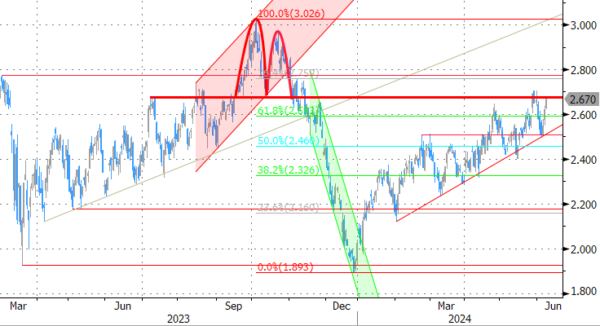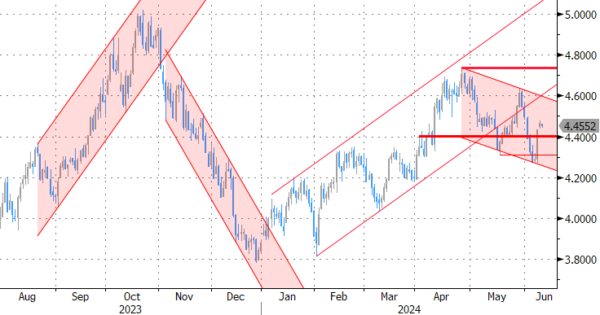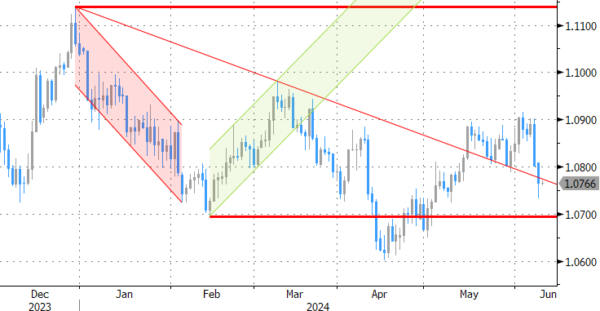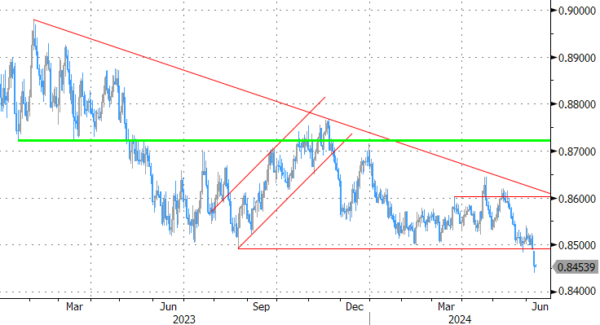Markets
It’s telling that core bonds do not gain when markets are in risk-off. German bunds underperformed US Treasuries yesterday with a political risk premium boosting yields between 0.2 (2-yr) and 6.8 bps (30-yr) higher. Far-right advanced (sharply) in the European parliamentary elections in many countries including Germany, Italy and France. In a direct consequence, the president of the latter announced snap parliamentary elections. It’s bound to keep political uncertainty lingering for the time being. Sovereign risk premia vs Germany’s 10-yr yield rose across the bloc with France underperforming peripheral countries. The euro didn’t forget about the 2012 debt/political crisis and proved very vulnerable. EUR/USD slipped below the 1.08 big figure to close at 1.0765. That’s off the intraday lows of 1.0733 though. EUR/GBP since mid-May hovered close to but above 0.85. Sterling lacked the strength for a sustained break lower but a weak euro yesterday eventually took care of it. The combo closed at the lowest level since August 2022 (0.8456). US yields added up to 4.3 bps at the long end of the curve. Yesterday’s $58 bn 3-yr auction raises the stakes for tonight’s $39bn 10-yr and Thursday’s $22bn 30-yr ones. Investor demand was mediocre at best with a below-average 2.43 bid-to-cover and the highest dealer takedown since December. The auction carried a 1.1 bp tail. European bourses ceded ground with the French CAC40 the obvious underperformer (-1.35%). Wall Street gapped lower at the open but managed to close in the green after recovering throughout the session.
In between this morning’s UK labour market report and tonight’s US auction, markets will probably trade cautious and without a clear direction ahead of the Fed policy meeting on Wednesday. We expect a solid floor under core/European bond yields. ECB’s Lagarde in an op-ed published this morning clearly stated one should not expect rate cuts at a predetermined pace. She didn’t exclude the possibility of having multiple meetings between one rate cut and another and vowed to keep policy restrictive (= policy rate above an increased (?!) neutral rate) for as long as needed. The British labour market data were mixed. Employment in the three months to April dropped a bigger-than-expected 139k after an already weak March number. The unemployment rate ticked higher to 4.4% vs 4.3% expected. Wage growth remained sticky but the gauge that excludes bonusses at least didn’t surprise to the upside this time around (6%). The figure including bonusses, however, did come in at a higher-than-expected 5.9%, matching the previous month’s upwardly revised figure. After falling of a cliff yesterday, EUR/GBP is recovering marginally to 0.846. We don’t think the move has strong legs though.
News & Views
The NY Fed’s May survey of consumer expectations were a mixed bag. They showed short-term inflation expectations (1-yr) declining slightly (3.3% to 3.2%) while remaining unchanged at the 3-yr horizon (2.8%) and rising from 2.8% to 3% on the 5-yr tenor. Labor market expectations were miscellaneous. Interestingly, households’ expectations for the stock market improved to a 3-yr high with households becoming also more optimistic about their financial situation a year from now. The share of respondents expecting to be financially the same or better off 12 months from now is 78.1%, the highest level since June 2021. Median expected growth in household income increased from 3%to 3.1%. Perceptions of credit access compared to a year ago were largely unchanged, while expectations about future credit access deteriorated.
Mexican president-elect Sheinbaum vowed to push through with proposed judicial reforms proposed by her predecessor, outgoing president Lopez Obrador. She wants them to be part of a first wave of legislation together with pension reforms for public workers, a ban on reelection to public office and assistance programs for woman and schoolchildren. The judicial reform would put judges elected by popular vote on the nation’s Supreme Court and other lower courts and is seen (by markets and opponents) as eroding checks on power. Ever since the Mexican presidential election earlier this month, Mexican assets have been underperforming. After the recent statements to push through, USD/MXN tested the recent tops around 18.50. This compares with pre-election levels of 17.
Graphs
GE 10y yield
The ECB cut its key policy rates by 25 bps at the June policy meeting. A more bumpy inflation path in H2 2024, the EMU economy gradually regaining traction and the Fed’s higher for longer US strategy make follow-up moves difficult. Markets are coming to terms with that. The German 10y yield set a new YtD top at 2.7%.
US 10y yield
The Fed in May acknowledged the lack of progress towards the 2% inflation objective, but Fed Chair Powell indicated that further tightening was unlikely. However, the FOMC Minutes still showed internal debate on whether policy is restrictive enough. Sticky inflation suggests any rate cut will be a tough balancing act while several policy makers hint at a higher neutral rate. The US 10-y yield is stuck in the 4.3/4.7% trading range.
EUR/USD
EUR/USD is stuck in the 1.06-1.09 range. The desynchronized rate cut cycle with the ECB exceptionally taking the lead, strong US May payrolls and a swing to the right in European elections pulled the pair away from 1.09 resistance. Focus turns to the US side of the story with May CPI inflation numbers and a more hawkish Fed looming on the horizon.
EUR/GBP
Debate at the Bank of England is focused at the timing of rate cuts. Slower than expected April disinflation and a surprise general election on July 4 suggest that a June cut in line with the ECB looks improbable. Sterling gained momentum with money markets now discounting a Fed-like scenario. EUR/GBP tested the 2023 & 2024 lows near 0.85. Euro weakness eventually pulled the trick after French president Macron called snap elections following a weak showing in EU elections.

















